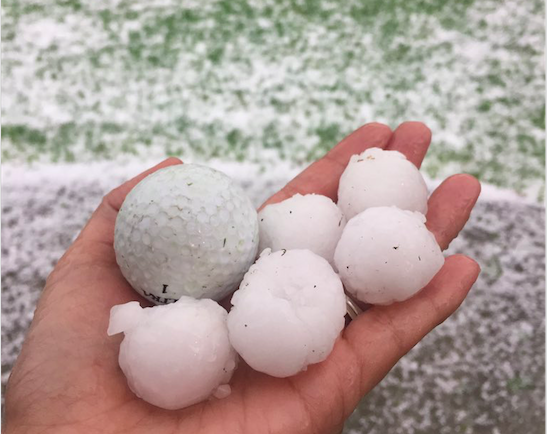This hailstorm was the costliest catastrophe in Colorado history
 |
Five years ago, Colorado experienced an enormously powerful hailstorm that left the Denver area with over $2 billion in damage.
Leading up to the disaster, Denver was coming off record-breaking heat that was impacting much of the area. On May 6, 2017, Denver reported a high temperature of 86 degrees, which set a daily high record. The following day, the city reached 80 degrees again.
The morning of May 8, 2017, started as another warm day for the Mile High City, with temperatures already at 73 degrees before noon, but a surface cold front moving into the area prevented a further increase in temperatures, bringing along with it a round of severe thunderstorms.
That afternoon, portions of northeastern Colorado and the Denver metro area were placed under a severe thunderstorm watch as the threat of large hail became apparent due to a steep lapse rate, according to the National Weather Service.
"Steeper lapse rates are going to correspond with stronger storm updrafts. Those strong updrafts are what help that large hail to form, as hail remains suspended inside the thunderstorm allowing for water droplets to continue to freeze and the hailstones to grow," said AccuWeather Meteorologist Danielle Knittle.
Thunderstorms began to develop around the Denver area just after noon, including one storm that would soon be known to Colorado as the costliest ever recorded.
Getting dime- to nickel-sized hail at our Evergreen office right now. pic.twitter.com/mZ9UBNwFaY
— Corinne Westeman (@cwesteman) May 8, 2017
Just before 2:30 p.m., a severe thunderstorm was spotted near Evergreen, Colorado, a town located in the mountains about 20 miles southwest of Denver. Dime- to nickel-sized hail was reported in Evergreen as the severe storm moved northeastward into the Rocky Mountain foothills.
As the severe storm continued its eastward trek toward Denver, hail size began to increase quickly. By 2:40 p.m., quarter-size hail was reported in Golden, Colorado, the first severe hail report for the Denver metro area caused by the storm.
The siding on homes in Golden, Colorado, was shredded like swiss cheese, with windows on some homes shattering as the hail came down. Considerable roof damage was reported in the area by the National Weather Service.
 |
Large hail that fell in Lakewood, Colorado, located near Denver, on Monday afternoon. (Photo/Twitter user @JuliaLytvyn) |
The severe hail continued to grow in size rapidly, and in just 10 minutes, the hail began to impact a several-mile-long corridor of the metro area, including Lakewood and Wheat Ridge. Golfball- and egg- sized hail began to damage buildings and vehicles in these locations.
The Lutheran Medical Center in Wheat Ridge was in the path of the record-breaking storm. Hail severely damaged over 100 cars in the parking lot. Richard Gilmore rushed to put a tarp over his wife's car after the hail storm obliterated her back windshield, while she was working in the building, according to ABC Denver.
"I just put $2,000 into maintenance of this car and replaced entire [sic] pieces of this car. Here I am, well now it really is totaled," Gilmore told ABC Denver following the storm.
The Colorado Bureau of Investigation office in Lakewood was in the direct path of the storm and sustained major damage. As hailstones breached the windows of the building, cubicles became destroyed, some ceiling tiles fell off and the office flooded as it rained inside.
 |
At 3:05 p.m., the largest hail report of the day occurred, when a trained spotter reported baseball-sized hail (2.75 inches in diameter) in an area of Wheat Ridge just south of Interstate 70. To the west of that report was Colorado Mills Mall in Lakewood, where some of the costliest damage from the storm occurred.
Those inside a local mall could hear the large hail as it came down on the building, damaging the roof and causing water to leak into the ceiling tiles. The weight of the water strained the tiles and caused them to collapse in the mall and at the movie theatre inside.
Shortly after, baseball-sized hail began to penetrate the skylight of the mall, shattering the glass ceiling and exposing the inside of the mall to the severe weather, forcing an evacuation.
"Lots of water on the ground, water leaking from the ceilings of all areas of the mall, the whole mall was evacuated. There was a lot of damage," Lindsay Jones, who worked at the mall during the storm, told ABC Denver. No one inside the mall was injured, but Lakewood Police said the building suffered substantial damage.
After causing significant damage to much of the western Denver suburbs, the severe hail storm began its impacts on the city of Denver, just in time for the start of the evening rush hour commute. Egg- and tennis ball-sized hail began to be recorded around northwestern and southwestern Denver.
Large hailstones caused damage to more homes in west Denver and posed a significant threat to drivers on the roadways.
Home after home after home with severe hail damage from yesterday's storm in West Denver #cowx pic.twitter.com/8Nl1mjTnYJ
— Daryl Orr (@WxWyDaryl) May 9, 2017
At this point, the storm was only a few miles away from downtown Denver and an increasingly busy junction between Interstate 70 and Interstate 25, the two major interstates in the state. This section of Interstate 25 carries over 200,000 vehicles per day, while Interstate 70 in that area is traveled by up to 220,000 per day.
The storm unloaded severe hail onto roadways across Denver, destroying windshields and denting vehicles. Driving speeds slowed significantly around the area as many attempted to find exits to shelter. Some vehicles even stopped completely to take shelter under overpasses, as seen on dashcam video from a driver that day.
Several other vehicles pulled onto the shoulder as hail began to damage their cars. A passenger of a car traveling on Interstate 70 had to shield herself as the hail sent windshield glass flooding into the car, as seen on dashcam video by a user named Preston B on YouTube.
Quarter- to golf ball-sized hail continued to cover downtown Denver, even coating Coors Field and delaying the start of an MLB game between the Colorado Rockies and Chicago Cubs.
Massive hail at Coors Field in #Colorado ahead of #Cubs #Rockies: pic.twitter.com/PLYyltuEZh
— MLB EXPERT PICKS (@MLBEXPERTPICKS) May 8, 2017
Impacts from the storm continued as it moved into Commerce City, which is just to the northeast of Denver. The hail finally began to shrink as it moved into the city, but the smaller hail accumulated like a winter storm, leaving more than a foot of hail accumulation in some parts. After impacting Commerce City, the storm continued its northeast track towards the airport. At Denver International Airport, over 150 flights were delayed as the storm moved to the northwest of the terminal and runways.
CLICK HERE FOR THE FREE ACCUWEATHER APP
By 4 p.m., the severe hail had moved out of the metro area, but the cleanup and impacts had only just begun. XcelEnergy reported that nearly 2,000 customers were without power in the Denver area following the severe thunderstorm.
 |
Several windows in buildings were destroyed, including at Beach Court Elementary School in Denver, where nearly 100 windows broke, according to The Denver Post. The school was forced to close for days as crews assessed damages. Other schools were also forced to close as a result of damage and flooding, including all those located in Adams County Schools District 14.
Shortly after the storm, city officials in Wheat Ridge reported that around half of all homeowners in the city had roof damage as a result of the storm, according to KUSA. Of the 14,000 homes in the city, over 7,000 permits were filed for roof repairs.
"I don't think anybody has seen this kind of level of damage. I mean, it was daunting," chief building official in Wheat Ridge, Brian Tardif, told KUSA in July 2017.
Damage in the area would take months to repair following the storm. Colorado Mills Mall remained closed for half a year as the mall underwent repairs and renovations. The construction didn't fully finish on the mall until 2018, according to Colorado Public Radio.
As a result of the extensive damage caused around the Denver metro area, the storm became not only the costliest hail storm in Colorado history but also the costliest catastrophe in state history, according to Rocky Mountain Insurance Information Association.
 |
This Colorado State patrol car had its window smashed by large hail on Monday afternoon. (Photo/Sergeant Mullins) |
More than 100,000 homeowner claims were filed, resulting in $1.4 billion in damages. This combined with the $873 million from 167,000 auto insurance claims raised the storm's total price tag to $2.3 billion in damages, according to The Denver Post.
At $2.3 billion in insured losses, the May 8, 2017 hail storm more than doubled the prior state record which was a hail and wind storm that caused over $750 million in insured losses to the Denver area in July 2009. The 2017 hailstorm was also the first disaster in Colorado history to eclipse $1 billion in insured losses.
At the time of impact, the storm became the second-costliest hail event in United States' history, topped only by a hail event in October 2010 that caused $2.81 billion in damages in Arizona. One month after the hail storm hit Colorado, a $2.5 billion hail event occurred in the Minneapolis metro area, leaving the 2017 Denver hail event as the third costliest hail storm in United States history, according to Car Covers.
Wait times for car and home repairs stretched several months due to the sheer amount of cases, according to The Denver Post. Some roof repairs didn't start until winter, while some auto body shops were unable to begin car repairs until over a year later.
"Right now, we are booking for Oct. 8, 2018, and there's other places around town that are saying 2019 before they'll even get you in for hail," Matt Walton of Lawson's Paint and Body told KDVR in November 2017.
Five years later, the 2017 hailstorm remains the costliest catastrophe in state history, only closely challenged by the Marshall wildfire, which caused $2 billion in insured losses in Boulder County late in 2021. It also remains the third costliest hail storm in United States history.
 |
Impacts from the hail storm five years ago can still be seen around the area today, from new windows and siding on homes to dents in vehicles that were impacted by the storm and not repaired.
Colorado is known as a hotspot for hail, with the front range being known as the heart of "Hail Alley." Hail storms are most common in Colorado during June, but destructive hail events in earlier months can still happen, as evidenced by the 2017 event.
For the latest weather news check back on AccuWeather.com. Watch the AccuWeather Network on DIRECTV, Frontier, Spectrum, fuboTV, Philo, and Verizon Fios.AccuWeather Now is now available on your preferred streaming platform.







